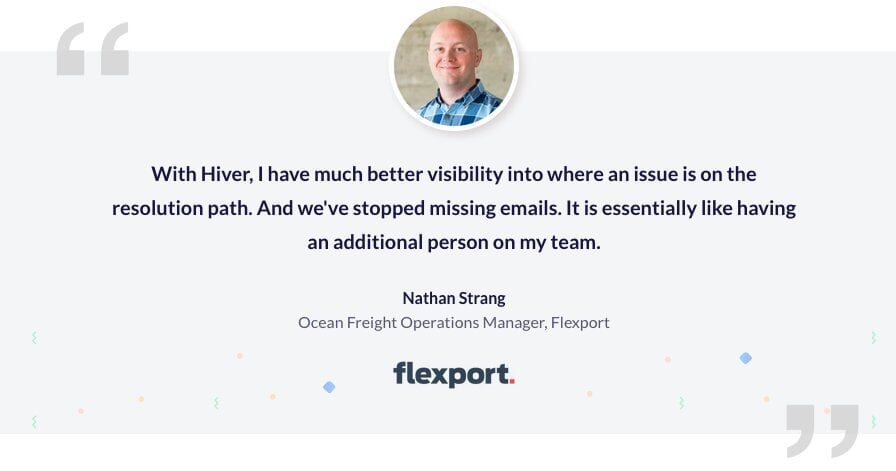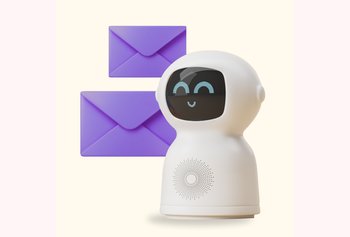Using Google Groups for Customer Support: Tips and Tools

Table of contents
The Google Groups tool is meant to make it easy for people with a Google account to work more efficiently in groups.
With the tool, email ids such as [email protected] can be mapped to a Google Group that comprise the email ids of individual team members.
Anyone in the group can read and reply to incoming mails. Access is easy, right from the Gmail inbox. Not surprisingly, businesses using Google Workspace (formerly G Suite) adopted Google Groups especially for business functions such as Customer Support that are highly email-intensive.
But the best intents and plans don’t always pan out as expected. And this has been true for Google Groups as well. It was not (and still isn’t) designed for use as an email client.
Its UI is quite different from that of Gmail or other Google apps. This means that it is not very intuitive to use, and users need to be specially trained. Nor has the tool’s UI changed much.

But the real challenge is this: although the tool is useful for sharing/broadcasting information within a group, its current UI and features do not make it truly useful for collaboration – especially for Customer Support.
In most organizations, a team of customer support executives is responsible for supporting customers. When emails come in, one of the team members must respond within the stipulated time so as to comply with SLAs/TATs. Anyone in the team can respond, but it is important that:
- No message remains unanswered; and
- Multiple people do not respond to the same customer email
Let’s go into the details of why Google Groups isn’t ideal for delivering customer service.
Recommended Read: 10 Best Google Groups Alternatives
Table of Contents
- Why Google Groups makes delivering support painful
- Manage Google Groups like a champ with Hiver – right from Gmail
- Try Hiver today!
Why Google Groups makes delivering support painful
Google Groups, which began as a collaborative space for online discussions, seemed like a natural solution when businesses started looking for ways to do customer support from their Gmail account.
Truth be told, Google Groups fell short on many accounts when it came to the collaborative requirements of support teams. For starters, there was no way to assign tasks.
To overcome these collaboration lapses, Google Collaborative Inbox feature came into being. While this new feature did have a few capabilities to make teamwork a little easier, the biggest issue is still its unintuitive UI.
Allow me to describe the other problems with Google Groups and Collaborative Inboxes:
1. High chances of email collisions
All incoming emails go to everyone in the Google group. But unless the agent who responds to a customer mail copies his/her reply to the group email address, others in the group will not know that a reply has been sent or what the reply is.
This increases the risk that some other agent in the group inadvertently replies to the same customer email.
Not only is this a waste of the team’s time (the second agent could have potentially handled another customer email),it also increases the risk of annoying customers and reducing satisfaction- a key metric to evaluate the team’s performance.
The situation gets worse if two different responses are sent by two different agents to the same customer!
2. Messy internal communication
There may be situations when an agent needs to check with a colleague who has prior experience in handling a similar customer issue.
With Google Groups, the agent seeking assistance will need to forward the email to the teammate; all these exchanges become part of the email thread.
If the company’s email policies/infrastructure are lax, agents may even be able to send emails to their personal addresses and from there, to people outside the organization.
In addition to raising the risk of confidential information going outside the company, this can put the customer’s privacy at risk.
Unless every agent is careful to cut-paste only the final response onto the original customer email every single time, the risk of the entire email thread (including internal communications amongst team members) being sent to the customer cannot be ruled out.
Unfortunately, such “leaks” are more common than one would expect or like.
3. No clear way to prioritize emails
Let’s face it- for businesses, not all customers are equal (though they really should be). Customers who contribute significantly to revenues or profits or are otherwise “strategic” are more valuable for businesses and accordingly, afforded priority treatment.
Or maybe there’s a customer who has had a series of problems (or the same one recurring). In all such cases, the support team will want to ensure priority attention and resolution.
The Google Groups UI does not allow emails to be flagged as a high priority. All that is possible is to send another mail to group members announcing the priority status. That’s way too many emails!
You could, of course, shout out to your colleagues if they are close by. But you could have agents around the world or someone could be working from a remote location or maybe has gone for a coffee break!
4. No analytics or reporting
Everyone swears by analytics these days, and yet, managing Google Groups with its native UI does not offer much information for generating analytical insights.
Managing customer expectations and providing them with support goes far beyond just replying to their emails in time; the content of the response is important as well, as is the time taken for the first response, tonality, and factual accuracy of the email, follow-ups, etc.
There are so many factors beyond average response time that need to be looked at to determine the overall quality of customer support and the performance of individual agents. And you just cannot do that with the current Google Groups UI.
This is a major lacuna for growing businesses that have diverse customer sets and are keen to learn from past mistakes and improve constantly.
Basically, Google Groups are sufficiently useful only when you have to broadcast information to a group of people. The moment you want to act on it by collaborating on the information, it becomes a mess.
Manage Google Groups like a champ with Hiver – right from Gmail
Hiver addresses the above shortcomings and helps transform Google Groups into a powerful collaboration tool.
It converts your Google Groups into shared inboxes — you can easily add members to the shared inbox and manage it right from your Gmail inbox.
Not only is it so much more intuitive and easier to use than the Google Groups UI, but it also provides various features that help the team do a better job of streamlining workflows and providing amazing customer support. It also helps team leaders manage group members more efficiently.
Google Groups with Hiver addresses all the gaps described in the previous section and gives your teams the collaboration and information-sharing capabilities they need to take their performance to a higher level.
Specifically, when you use Hiver to manage your Google Groups, you can do the following:
- Automate the process of assigning incoming emails to specific individuals, thus reducing the risk that some emails remain unanswered or that multiple agents respond inadvertently to the same customer email.
- Track the status of emails without having to ask agents if they have replied to every single email.
- Ensure that internal exchanges between team members and other stakeholders is isolated, thereby reducing the risk that internal communications don’t go to the customer, even inadvertently.
- Eliminate the risk of e-mail collisions caused by “blind spots”.
- Leverage templates to respond to frequently asked customer queries.
- Flag priority mails as soon as they hit your Google.
- Groups inbox so that they are assigned and handled on a priority basis.
- Monitor workloads and measure agent performance using metrics that go beyond the average number of emails sent by an individual.
- Coach individual agents and tweak processes, roles and metrics to constantly raise the bar so that customer support standards improve, leading to higher customer satisfaction scores.
Let’s look at how Hiver actually helps Customer Support teams achieve the above.
1. All the action — right inside Gmail
The moment an email arrives into your Google Group, it appears in the Hiver Shared Inbox. This is easily accessible from the Gmail sidebar.
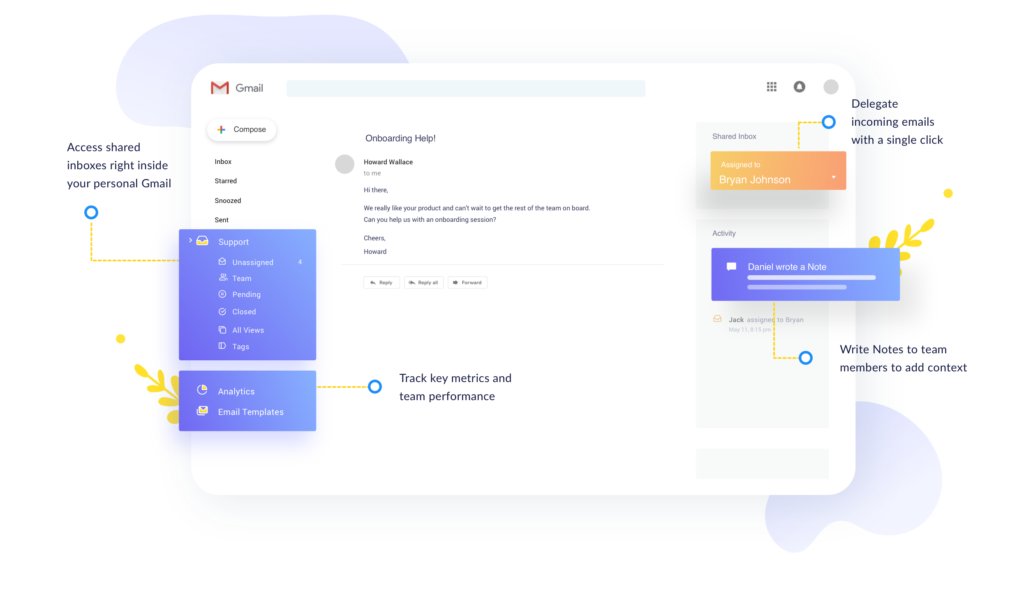
Anyone who is a part of the shared inbox can access and process all the emails in the Google Group. So, there is no risk of work being adversely impacted if the group owner or “Administrator” is on leave or not available. All it takes is two clicks from the Gmail sidebar.
2. Your team is always on the same page
Every member on the email list of the shared inbox can easily see how many emails are unassigned, how many are assigned to him/her, how many have already been assigned, and how many have been closed. This virtually eliminates the risk that an email gets missed.
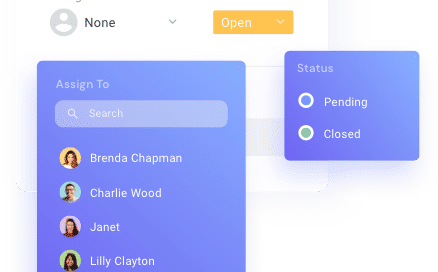
Anyone in the team can access the shared inboxes from the left panel in Gmail to view assigned and unassigned tasks.
3. Tracking status is a breeze
If someone wants to know the status of an open ticket or needs to find out who responded to an old email, you will no longer have to ask everyone in the team chat and rely on their timely responses (or potentially unreliable memories).
When an email is assigned to someone, the entire team will simultaneously know to whom it has been assigned. Other team members can, if necessary, provide information to the individual or from a continuity perspective, get the email reassigned to him/herself. This also minimizes the risk that two (or God forbid, more!) agents respond to the same email.
4. Making teamwork easy (like truly easy)
Asking colleagues for help or advice when dealing with a customer situation is not a bad thing. But when you manage a Google Group using the Google UI, e-mails are often the easiest way to give a colleague the context and seek advice.
With Hiver to manage Google Groups, internal communications between team members become easier, less obtrusive, and significantly less risky. Hiver offers the ability to write Email Notes that are chat messages that live right next to your email communication. The advantage is that they are not part of the email threads; besides, they are easy to trace and refer back to.

Using Hiver’s Notes feature, you can communicate with anyone who’s a part of the shared inbox. Notes are useful in a variety of situations, such as these:
- If you want to broadcast a question to everyone in the group, start the note with @all and it will notify everyone in the group. Anyone in the group can reply to your note.
- If you want to reach out to a specific person, start the note with @name and only that person will receive a notification. You can now exchange messages with that person like you would on personal chat.
- If you want to add some context or learning that you think might come in handy in the future, just add it to the Note; it will stay alongside the email.
Even if a customer interaction is closed, the Notes stay alongside the email conversation. This makes it easy to go back to old interactions as well (for training purposes or if they were handled by people who have since left the organization).
5. Keeping duplication at bay
E-mail collisions are every customer support team’s nightmare. They arise because of blind spots, caused because nobody (other than the agent working on it) knows who is working on a particular customer email.
More information may be needed from the customer- and two agents write back asking the same question. The customer is annoyed but replies to one of the emails. And then, the other agent follows up on his/her first mail, further aggravating the customer.
When you use Hiver to manage your Google Groups, the risk of e-mail collisions is all but eliminated, thanks to the Collision Alerts feature. This feature lets you know when someone else is replying to the same email or has replied a while back.
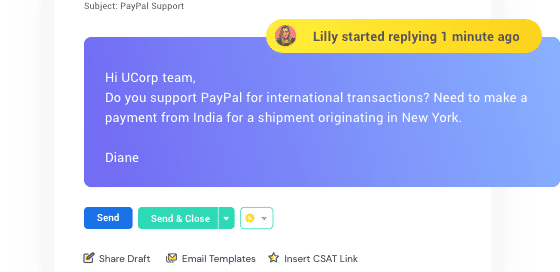
6. Keep a tab on your team’s performance
Lack of customer complaints does not necessarily mean your team is doing a great job. Studies show that less than 5% of customers speak up or complain about poor service. A majority of them simply move to competitors.
Hiver is useful not just as a communication tool for the team; it also provides relevant data that can be used to objectively assess individual/team performance. Thus, you can ensure that your customer support levels don’t get hit.
When you use Google UI to manage Google Groups, the only data you can get is the number of messages received and sent.
Hiver’s shared inbox analytics gives you data to track metrics such as average response times and the number of queries resolved. The latter is important because not every email sent leads to a satisfactory resolution of the issue.
Also, because you can assign emails to individual agents, you can track indicators such as how many emails an agent takes on average to close a ticket, or how many tickets each agent is able to handle per day. You can compare data across months and shifts.
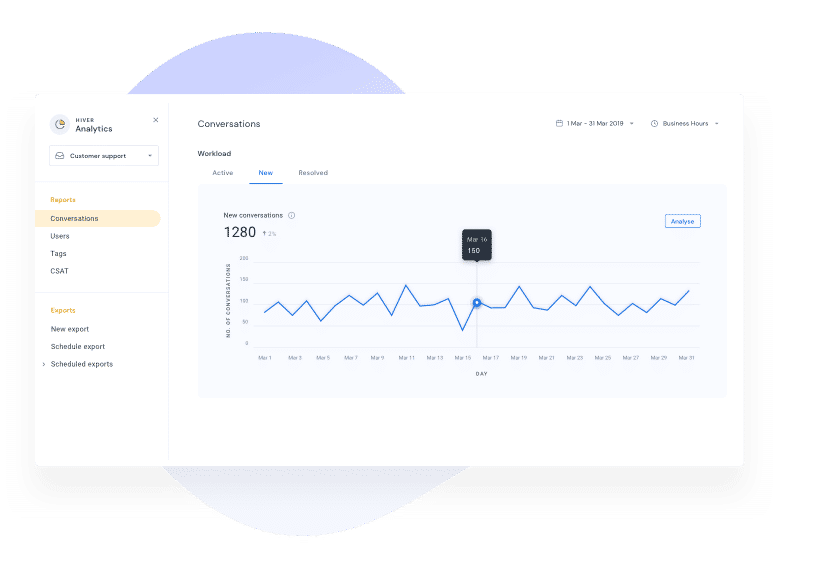
Try Hiver today!
Hiver – the world’s first customer service software designed for Google Workspace, is built to help companies deliver stellar customer service via email and live chat, without the hassle of adapting to alien software. You can start a free 7-day trial of Hiver today (no credit card required). Alternatively, you can also request a demo of the tool to see how Hiver helps turn things around for your customer support team.











